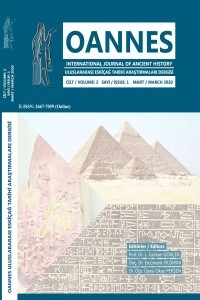
OANNES - Uluslararası Eskiçağ Tarihi Araştırmaları Dergisi
Yazarlar: Hasan Ali ŞAHİN
Konular:Tarih
DOI:10.33469/oannes.15
Anahtar Kelimeler:Tabal,Que,Meliddu,Kummuh,Gurgum,Carchemish,Hieroglyphic Inscriptions
Özet: Despite the disappearance of the Hittite Empire, the southeastern states continued to maintain Hittite culture for nearly five centuries. In the Assyrian records, Syria and the Taurus Mountains continued to be referred to as the ‘Hatti Country. Late Hittite kingdoms erected many rock monuments with Hittite hieroglyphs in their regions. From this point of view, it can be said that the Hittite cultures and traditions continued to be effective through the Late Hittite Kingdoms until the regions from Malatya in the north to the Palestinian borders in the south under Assyrian rule. After the collapse of the Hittite Empire, the Phrygians became dominant in Western Anatolia and the Urartians in Eastern Anatolia. In the region between the two states, the late Hittite principalities emerged. In this context, in the region covering Kayseri, Nevşehir, Niğde, Tabal, Melitene / Meliddu in today's Malatya province and the northern region of Maraş, Gurgum around Maraş, Kummuh in Adıyaman Province, Que in Adana Province, Pattin in Hatay region and in the Carchemish districts with the same name were established around. During this period, the Arami tribes established kingdoms in Syria. The first and most powerful of these was Damaskos (Damascus). The dynasties of Til-Barsip, Ya’diya and Arpad were overthrown and Aramis succeeded. Ya’diya’s name was changed to Sam’al. Til-Barsip and Arpad took the names Bit Adini and Bit Agusi and became the capitals of the new kingdoms. The Assyrian kings receiving taxes from the Aramaic and Hittite kingdoms did not affect the prosperity and abundance. Hittite culture spread southward to Palestine. Assyrian regained power and organized Syrian campaigns during the Asurnasirpal period and took control of almost all the land east of the Euphrates.